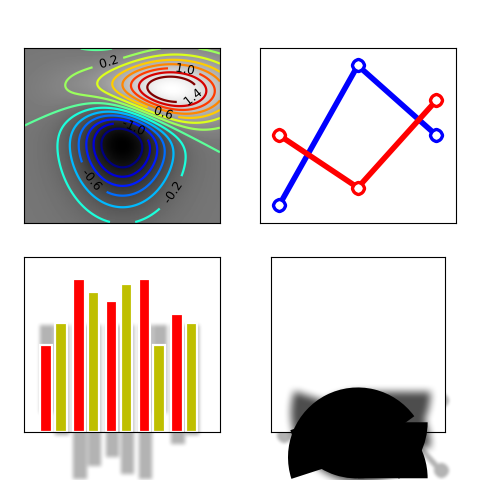

(Source code, png)

import matplotlib.pyplot as plt
import numpy as np
import matplotlib.cm as cm
import matplotlib.mlab as mlab
def smooth1d(x, window_len):
# copied from http://www.scipy.org/Cookbook/SignalSmooth
s = np.r_[2*x[0] - x[window_len:1:-1], x, 2*x[-1] - x[-1:-window_len:-1]]
w = np.hanning(window_len)
y = np.convolve(w/w.sum(), s, mode='same')
return y[window_len-1:-window_len+1]
def smooth2d(A, sigma=3):
window_len = max(int(sigma), 3)*2 + 1
A1 = np.array([smooth1d(x, window_len) for x in np.asarray(A)])
A2 = np.transpose(A1)
A3 = np.array([smooth1d(x, window_len) for x in A2])
A4 = np.transpose(A3)
return A4
class BaseFilter(object):
def prepare_image(self, src_image, dpi, pad):
ny, nx, depth = src_image.shape
#tgt_image = np.zeros([pad*2+ny, pad*2+nx, depth], dtype="d")
padded_src = np.zeros([pad*2 + ny, pad*2 + nx, depth], dtype="d")
padded_src[pad:-pad, pad:-pad, :] = src_image[:, :, :]
return padded_src # , tgt_image
def get_pad(self, dpi):
return 0
def __call__(self, im, dpi):
pad = self.get_pad(dpi)
padded_src = self.prepare_image(im, dpi, pad)
tgt_image = self.process_image(padded_src, dpi)
return tgt_image, -pad, -pad
class OffsetFilter(BaseFilter):
def __init__(self, offsets=None):
if offsets is None:
self.offsets = (0, 0)
else:
self.offsets = offsets
def get_pad(self, dpi):
return int(max(*self.offsets)/72.*dpi)
def process_image(self, padded_src, dpi):
ox, oy = self.offsets
a1 = np.roll(padded_src, int(ox/72.*dpi), axis=1)
a2 = np.roll(a1, -int(oy/72.*dpi), axis=0)
return a2
class GaussianFilter(BaseFilter):
"simple gauss filter"
def __init__(self, sigma, alpha=0.5, color=None):
self.sigma = sigma
self.alpha = alpha
if color is None:
self.color = (0, 0, 0)
else:
self.color = color
def get_pad(self, dpi):
return int(self.sigma*3/72.*dpi)
def process_image(self, padded_src, dpi):
#offsetx, offsety = int(self.offsets[0]), int(self.offsets[1])
tgt_image = np.zeros_like(padded_src)
aa = smooth2d(padded_src[:, :, -1]*self.alpha,
self.sigma/72.*dpi)
tgt_image[:, :, -1] = aa
tgt_image[:, :, :-1] = self.color
return tgt_image
class DropShadowFilter(BaseFilter):
def __init__(self, sigma, alpha=0.3, color=None, offsets=None):
self.gauss_filter = GaussianFilter(sigma, alpha, color)
self.offset_filter = OffsetFilter(offsets)
def get_pad(self, dpi):
return max(self.gauss_filter.get_pad(dpi),
self.offset_filter.get_pad(dpi))
def process_image(self, padded_src, dpi):
t1 = self.gauss_filter.process_image(padded_src, dpi)
t2 = self.offset_filter.process_image(t1, dpi)
return t2
from matplotlib.colors import LightSource
class LightFilter(BaseFilter):
"simple gauss filter"
def __init__(self, sigma, fraction=0.5):
self.gauss_filter = GaussianFilter(sigma, alpha=1)
self.light_source = LightSource()
self.fraction = fraction
def get_pad(self, dpi):
return self.gauss_filter.get_pad(dpi)
def process_image(self, padded_src, dpi):
t1 = self.gauss_filter.process_image(padded_src, dpi)
elevation = t1[:, :, 3]
rgb = padded_src[:, :, :3]
rgb2 = self.light_source.shade_rgb(rgb, elevation,
fraction=self.fraction)
tgt = np.empty_like(padded_src)
tgt[:, :, :3] = rgb2
tgt[:, :, 3] = padded_src[:, :, 3]
return tgt
class GrowFilter(BaseFilter):
"enlarge the area"
def __init__(self, pixels, color=None):
self.pixels = pixels
if color is None:
self.color = (1, 1, 1)
else:
self.color = color
def __call__(self, im, dpi):
pad = self.pixels
ny, nx, depth = im.shape
new_im = np.empty([pad*2 + ny, pad*2 + nx, depth], dtype="d")
alpha = new_im[:, :, 3]
alpha.fill(0)
alpha[pad:-pad, pad:-pad] = im[:, :, -1]
alpha2 = np.clip(smooth2d(alpha, self.pixels/72.*dpi) * 5, 0, 1)
new_im[:, :, -1] = alpha2
new_im[:, :, :-1] = self.color
offsetx, offsety = -pad, -pad
return new_im, offsetx, offsety
from matplotlib.artist import Artist
class FilteredArtistList(Artist):
"""
A simple container to draw filtered artist.
"""
def __init__(self, artist_list, filter):
self._artist_list = artist_list
self._filter = filter
Artist.__init__(self)
def draw(self, renderer):
renderer.start_rasterizing()
renderer.start_filter()
for a in self._artist_list:
a.draw(renderer)
renderer.stop_filter(self._filter)
renderer.stop_rasterizing()
import matplotlib.transforms as mtransforms
def filtered_text(ax):
# mostly copied from contour_demo.py
# prepare image
delta = 0.025
x = np.arange(-3.0, 3.0, delta)
y = np.arange(-2.0, 2.0, delta)
X, Y = np.meshgrid(x, y)
Z1 = mlab.bivariate_normal(X, Y, 1.0, 1.0, 0.0, 0.0)
Z2 = mlab.bivariate_normal(X, Y, 1.5, 0.5, 1, 1)
# difference of Gaussians
Z = 10.0 * (Z2 - Z1)
# draw
im = ax.imshow(Z, interpolation='bilinear', origin='lower',
cmap=cm.gray, extent=(-3, 3, -2, 2))
levels = np.arange(-1.2, 1.6, 0.2)
CS = ax.contour(Z, levels,
origin='lower',
linewidths=2,
extent=(-3, 3, -2, 2))
ax.set_aspect("auto")
# contour label
cl = ax.clabel(CS, levels[1::2], # label every second level
inline=1,
fmt='%1.1f',
fontsize=11)
# change clable color to black
from matplotlib.patheffects import Normal
for t in cl:
t.set_color("k")
# to force TextPath (i.e., same font in all backends)
t.set_path_effects([Normal()])
# Add white glows to improve visibility of labels.
white_glows = FilteredArtistList(cl, GrowFilter(3))
ax.add_artist(white_glows)
white_glows.set_zorder(cl[0].get_zorder() - 0.1)
ax.xaxis.set_visible(False)
ax.yaxis.set_visible(False)
def drop_shadow_line(ax):
# copied from examples/misc/svg_filter_line.py
# draw lines
l1, = ax.plot([0.1, 0.5, 0.9], [0.1, 0.9, 0.5], "bo-",
mec="b", mfc="w", lw=5, mew=3, ms=10, label="Line 1")
l2, = ax.plot([0.1, 0.5, 0.9], [0.5, 0.2, 0.7], "ro-",
mec="r", mfc="w", lw=5, mew=3, ms=10, label="Line 1")
gauss = DropShadowFilter(4)
for l in [l1, l2]:
# draw shadows with same lines with slight offset.
xx = l.get_xdata()
yy = l.get_ydata()
shadow, = ax.plot(xx, yy)
shadow.update_from(l)
# offset transform
ot = mtransforms.offset_copy(l.get_transform(), ax.figure,
x=4.0, y=-6.0, units='points')
shadow.set_transform(ot)
# adjust zorder of the shadow lines so that it is drawn below the
# original lines
shadow.set_zorder(l.get_zorder() - 0.5)
shadow.set_agg_filter(gauss)
shadow.set_rasterized(True) # to support mixed-mode renderers
ax.set_xlim(0., 1.)
ax.set_ylim(0., 1.)
ax.xaxis.set_visible(False)
ax.yaxis.set_visible(False)
def drop_shadow_patches(ax):
# copyed from barchart_demo.py
N = 5
menMeans = (20, 35, 30, 35, 27)
ind = np.arange(N) # the x locations for the groups
width = 0.35 # the width of the bars
rects1 = ax.bar(ind, menMeans, width, color='r', ec="w", lw=2)
womenMeans = (25, 32, 34, 20, 25)
rects2 = ax.bar(ind + width + 0.1, womenMeans, width, color='y', ec="w", lw=2)
#gauss = GaussianFilter(1.5, offsets=(1,1), )
gauss = DropShadowFilter(5, offsets=(1, 1), )
shadow = FilteredArtistList(rects1 + rects2, gauss)
ax.add_artist(shadow)
shadow.set_zorder(rects1[0].get_zorder() - 0.1)
ax.set_xlim(ind[0] - 0.5, ind[-1] + 1.5)
ax.set_ylim(0, 40)
ax.xaxis.set_visible(False)
ax.yaxis.set_visible(False)
def light_filter_pie(ax):
fracs = [15, 30, 45, 10]
explode = (0, 0.05, 0, 0)
pies = ax.pie(fracs, explode=explode)
ax.patch.set_visible(True)
light_filter = LightFilter(9)
for p in pies[0]:
p.set_agg_filter(light_filter)
p.set_rasterized(True) # to support mixed-mode renderers
p.set(ec="none",
lw=2)
gauss = DropShadowFilter(9, offsets=(3, 4), alpha=0.7)
shadow = FilteredArtistList(pies[0], gauss)
ax.add_artist(shadow)
shadow.set_zorder(pies[0][0].get_zorder() - 0.1)
if 1:
plt.figure(1, figsize=(6, 6))
plt.subplots_adjust(left=0.05, right=0.95)
ax = plt.subplot(221)
filtered_text(ax)
ax = plt.subplot(222)
drop_shadow_line(ax)
ax = plt.subplot(223)
drop_shadow_patches(ax)
ax = plt.subplot(224)
ax.set_aspect(1)
light_filter_pie(ax)
ax.set_frame_on(True)
plt.show()
Keywords: python, matplotlib, pylab, example, codex (see Search examples)